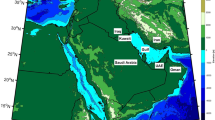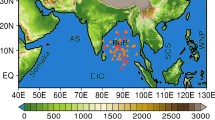Abstract
Through its various radiative effects and latent heat release, water plays a major role in the maintenance of climate. Therefore a better understanding of climate and climate changes requires a better understanding of the hydrological cycle. In this study we investigate the scale-decomposed atmospheric water budget over North America as simulated by the Canadian Regional Climate Model (CRCM) driven by the Canadian Coupled Global Climate Model (CGCM) under current conditions for 1961–1990 and the SRES A2 scenario for 2041–2070. A discrete cosine transform is applied to the atmospheric water budget variables in order to separate small scales that are resolved exclusively by the high-resolution CRCM, from larger scales resolved by both the CRCM and low-resolution driving CGCM. The moisture flux divergence is alternatively decomposed in terms of three scales of wind and humidity to provide nine interaction terms. Statistics of these fields are calculated for winter and summer seasons, and the local statistical significance of climate-change projections is tested. The contributions of each scale band to the water budget current climatology and to its evolution in a warmer climate are investigated, addressing the issue of the potential added value of smaller scales. Results show a time variability larger than the time mean for all variables, and a significant small-scale contribution to time variability, which is even dominant in summer, both in the current and future climates. Future climate exhibits an overall intensification of the hydrological cycle in winter, and more mixed changes in summer. Relative changes in the time mean and time variability appear comparable, and the contribution of each scale band to variability changes remains overall very consistent with their contribution to current climate variability.















Similar content being viewed by others
References
Allen MR, Ingram WJ (2002) Constraints on the future changes in climate and the hydrological cycle. Nature 419:224–232
Arakawa A, Lamb V (1977) Computational design of the basic dynamical processes of UCLA General Circulation Model. Methods in computational physics, vol 17. Academic Press, New York, pp 173–265
Bechtold P, Bazile E, Guichard F, Mascart P, Richard E (2001) A mass-flux convection scheme for regional and global models. Q J R Meteorol Soc 127:869–886
Bergeron G, Laprise L, Caya D (1994) Formulation of the Mesoscale Compressible Community (MC2) Model. Internal report from Cooperative Centre for Research in Mesometeorology, pp 165
Bielli S, Laprise R (2006) A methodology for the regional-scale-decomposed atmospheric water budget: application to a simulation of the Canadian Regional Climate Model nested by NCEP-NCAR reanalyses over North America. Mon Weather Rev 134:854–873
Bielli S, Laprise R (2007) Time mean and variability of the scale-decomposed atmospheric water budget in a 25-year simulation of the Canadian Regional Climate Model over North America. Clim Dyn 29:763–777
Boer GJ (1982) Diagnostic equations in isobaric coordinates. Mon Weather Rev 110:1801–1820
Boer GJ (1994) Mean and transient spectral energy and enstrophy budgets. J Atmos Sci 51:1765–1779
Boer GJ, Shepherd TG (1983) Large-scale two-dimensional turbulence in the atmosphere. J Atmos Sci 40:164–184
Boyd JP (2005) Limited-area Fourier spectral models and data analysis schemes: windows, Fourier extension, Davies relaxation, and all that. Mon Weather Rev 133:2030–2042
Caya D, Laprise R (1999) A semi-implicit semi-Lagrangian regional climate model: The Canadian RCM. Mon Weather Rev 127:341–362
Christensen JH, Hewitson B, Busuioc A, Chen A, Gao X, Held I, Jones R, Kolli RK, Kwon W‐T, Laprise R, Magaña Rueda V, Mearns L, Menéndez CG, Räisänen J, Rinke A, Sarr A, Whetton P (2007) Regional climate projections. In: Solomon S, Qin D, Manning M, Chen Z, Marquis M, Averyt KB, Tignor M, Miller HL (eds) Climate change 2007: the physical science basis. Contribution of Working Group I to the fourth assessment report of the Intergovernmental Panel on Climate Change. Cambridge University Press, Cambridge
Davies HC (1976) A lateral boundary formulation for multi-level prediction models. Q J R Meteorol Soc 102:405–418
Denis B, Côté J, Laprise R (2002) Spectral decomposition of two-dimensional atmospheric fields on limited-area domains using the discrete cosine transform (DCT). Mon Weather Rev 130:1812–1829
Efron B, Tibshirani TJ (1993) An introduction to the bootstrap. Chapman and Hall, Norwell, p 436
Errico RM (1985) Spectra computed from a limited area grid. Mon Weather Rev 113:1554–1562
Feser F (2006) Enhanced detectability of added value in limited-area model results separated into different spatial scales. Mon Weather Rev 134:2180–2190
Flato GM, Boer GJ (2001) Warming asymmetry in climate change simulations. Geophys Res Lett 28:195–198
Gal-Chen T, Somerville RCJ (1975) On the use of a coordinate transformation for the solution of the Navier–Stokes equations. J Comp Phys 17:209–228
Giorgi F, Marinucci MR (1996) An investigation of the sensitivity of simulated precipitation to model resolution and its implications for climate studies. Mon Weather Rev 124:148–166
Iorio JP, Duffy PB, Govindasamy B, Thompson SL, Khairoutdinov M, Randall D (2004) Effects of model resolution and subgrid-scale physics on the simulation of precipitation in the continental United States. Clim Dyn 23:243–258
Kain JS, Fritsch JM (1990) A one-dimensional entraining/detraining plume model and application in convective parameterization. J Atmos Sci 47:2784–2802
Laprise R (1992) The resolution of global spectral models. Bull Am Meteorol Soc 73:1453–1454
Laprise R (2003) Resolved scales and nonlinear interactions in limited-area models. J Atmos Sci 60:768–779
Laprise R (2008) Regional climate modelling. J Comp Phys 227:3641–3666 Special issue on « Predicting weather, climate and extreme events »
Laprise R, Girard C (1990) A spectral general circulation model using a piecewise-constant finite element representation on a hybrid vertical coordinate system. J Clim 3:32–52
Laprise R, Caya D, Bergeron G, Giguère M (1997) The formulation of André Robert MC2 (mesoscale compressible community) model. Atmos Ocean 35:195–220
Lawford RG, Stewart R, Roads J, Isemer H-J, Manton M, Marengo J, Yasunari T, Benedict S, Koike T, Williams S (2004) Advancing global- and continental-scale hydrometeorology: contributions of GEWEX hydrometeorology panel. Bull Am Meteorol Soc 85:1917–1930
Lawford RG, Roads J, Lettenmaier DP, Arkin P (2007) GEWEX contributions to large-scale hydrometeorology. J Hydrometeor 8:629–641
McFarlane NA, Scinocca JF, Lazare M, Harvey R, Verseghy D, Li J (2005) The CCCma third generation atmospheric general circulation model. CCCma internal report, pp 25
Music B, Caya D (2007) Evaluation of the hydrological cycle over the Mississippi River basin as simulated by the Canadian Regional Climate Model (CRCM). J Hydrometeor 8:969–988
Music B, Caya D (2009) Investigation of the sensitivity of water cycle components simulated by the Canadian Regional Climate Model (CRCM) to the land surface parameterization, the lateral boundary data and the internal variability. J Hydrometeor 10:3–21
Nakicenovich N et al (2000) IPCC special report on emissions scenarios. Cambridge University Press, Cambridge, p 599
Paquin D, Caya D (2000) New convection scheme in the Canadian Regional Climate Model. Res Act Atmos Ocean Model 30:7.14–7.15
Peixoto J, Oort A (1992) Physics of climate. American Institute of Physics, USA, p 520
Riette S, Caya D (2002) Sensitivity of short simulations to the various parameters in the new CRCM spectral nudging. Res Act Atmos Ocean Model 32:7.39–7.40
Scinocca JF, McFarlane NA (2004) The variability of modelled tropical precipitation. J Atmos Sci 61:1993–2015
Trenberth KE (1998) Atmospheric moisture residence times and cycling: implications for rainfall rates with climate change. Clim Change 39:667–694
Trenberth KE (1999a) Conceptual framework for changes of extremes of the hydrological cycle with climate change. Clim Change 42:327–339
Trenberth KE (1999b) Atmospheric moisture recycling: role of advection and local evaporation. J Clim 12:1368–1381
Trenberth KE, Dai A, Rasmussen RM, Parsons DB (2003) The changing character of precipitation. Bull Am Meteorol Soc 84:1205–1217
Van Tuyl AH, Errico RM (1989) Scale interaction and predictability in a mesoscale model. Mon Weather Rev 117:495–517
Verseghy DL (1991) CLASS—a Canadian Land Surface Scheme for GCMs. Part I: soil model. Int J Climatol 11:111–113
Verseghy DL, McFarlane NA, Lazare M (1993) CLASS—a Canadian Land Surface Scheme for GCMs. Part II: vegetation model and coupled runs. Int J Climatol 13:347–370
Yakimiw E, Robert A (1990) Validation experiments for a nested grid-point regional forecast model. Atmos Ocean 28:466–472
Acknowledgments
This research was done as part of the Masters project of the first author and as a project within the Canadian Regional Climate Modelling and Diagnostics (CRCMD) Network, funded by the Canadian Foundation for Climate and Atmospheric Sciences (CFCAS) and the Ouranos Consortium for Regional Climatology and Adaptation to Climate Change. Ouranos also provided office space. We would like to thank Mr. Mourad Labassi for maintaining a user-friendly local computing facility. Thanks are also extended to the Ouranos Climate Simulation Team for their support of the CRCM software and for providing access to the climate simulations analysed here. Discussions with Dr. Soline Bielli have also been deeply appreciated. Finally, we would like to thank the three anonymous reviewers, whose suggestions contributed to improve the manuscript.
Author information
Authors and Affiliations
Corresponding author
Rights and permissions
About this article
Cite this article
Bresson, R., Laprise, R. Scale-decomposed atmospheric water budget over North America as simulated by the Canadian Regional Climate Model for current and future climates. Clim Dyn 36, 365–384 (2011). https://doi.org/10.1007/s00382-009-0695-4
Received:
Accepted:
Published:
Issue Date:
DOI: https://doi.org/10.1007/s00382-009-0695-4




